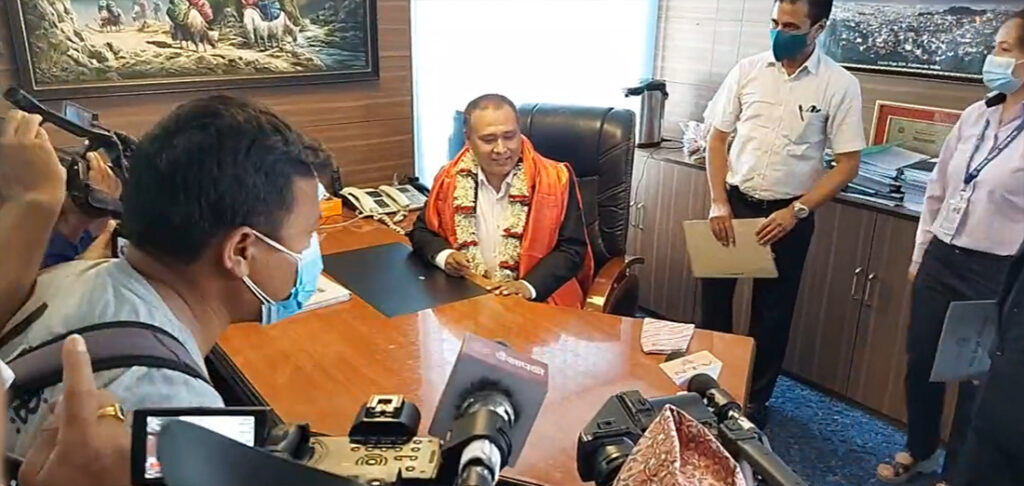By Karuna Thapa
Kathmandu, February 20
In the first six months of the current Fiscal Year (FY) 2078/79 (2022), the Nepal Electricity
Authority made a profit of Rs. 12.12 billion. The profit for the fiscal year 2077/78 (2021) was Rs. 6.18 billion.
The earnings of the Nepal Electricity Authority (NEA) grew to Rs 12.12 billion in the first six
months of the current fiscal year, according to the NEA. At the same time, it has become the most profitable of the public sector institutions. NEA has achieved rapid progress in the current fiscal year, despite having an annual deficit of Rs. 8 billion 890 million in FY 2072/73 (2016). The profit from the previous year was down somewhat.
Due to the control of electricity leakage, increased electricity export to India decreased
electricity import, increased electricity sales, and increased other income, NEA Executive
Director Kulman Ghising said the organization was able to earn a significant profit in the first six months of the current fiscal year.
The improvement in profits, according to Executive Director Ghising, is due to lower operational expenses, administrative and financial reforms, and the fact that the power purchase rate for the 456 MW Upper Tamakoshi is lower than other private sector projects.
”Consumer pricing revisions took effect in December, which may have an impact on profits as revenue decreases somewhat for the rest of the fiscal year,” Ghising added. ”However, we are working to improve leakage control and tighten financial discipline to lower profits by Rs 15 billion.”
In the first six months of the current fiscal year, NEA earned Rs 47.98 billion and spent Rs 35.86 billion. The sale and purchase of energy are NEA’s primary sources of revenue and spending.
Foreign donors’ long-term debt to NEA has reached Rs. 114 billion. The government of Nepal has a long-term debt of Rs. 81.81 billion, while employees have long-term debt of Rs. 36.84 billion.
NEA has Rs 165 billion in capital assets, Rs 152 billion in assets to be capitalized, Rs 35.34 billion in subsidiary investments, and Rs 32.50 billion in loan investments. The amount of liquid capital is 85.10 billion dollars.
Exports of electricity grew, while imports fell
In the first six months of the current fiscal year, Nepal’s excess electricity consumption climbed, exports to India increased, and the amount of insufficient electricity reduced, compared to prior years. In the previous fiscal year, electricity worth Rs 316 million was exported to India, whereas electricity of Rs 805 million were shipped in the first six months of this fiscal year. Energy exports have climbed from 44 million units last year to 173 million units in the first six months of this year.
Electricity imports grew from Rs. 13.42 billion in FY 2076/77 to Rs. 21.82 billion the previous fiscal year. In the first six months of the current fiscal year, however, only Rs 2.58 billion was imported.
Although imports would rise in January and February, Executive Director Ghising predicts that they will not exceed Rs 10 billion this year.
The demand for power has increased by around 200 MW this year compared to the previous year. The power system has been expanded by about 660 MW, including the 456 MW Upper Tamakoshi.
The leakage of electricity has decreased to 14.45 percent
In the first six months of this fiscal year, electricity leakage reduced to 14.45 percent. NEA has decreased system leakage from 17.18 percent last fiscal year to 14.45 percent in the first six months of this fiscal year, a decrease of 2.73 percentage points.
The leakage rate, which includes power transmission and distribution, fell to 14.45 percent in the first six months of the current fiscal year. The majority of the system’s leakage occurs at the distribution level. During this time, there was a 9.23% leakage towards distribution. In the current fiscal year, the NEA has set a goal of lowering electricity leakage to 15.5 percent.
According to Executive Director Ghising, the NEA’s profit has improved as a result of greater revenue due to lower leakage. According to Ghising, the leakage control program was successful, with substation capacity increased, conductors added, overloaded transformers replaced, and the use of three-phase meters encouraged.
To combat non-technical leakage, the NEA will prosecute those who steal meters by bypassing and connecting them, reselling meters, resetting meters, modifying meters, encouraging people to steal meters, and identifying customers without reading meters (stock unit), the campaign is running to find out such issues and take effective action.




